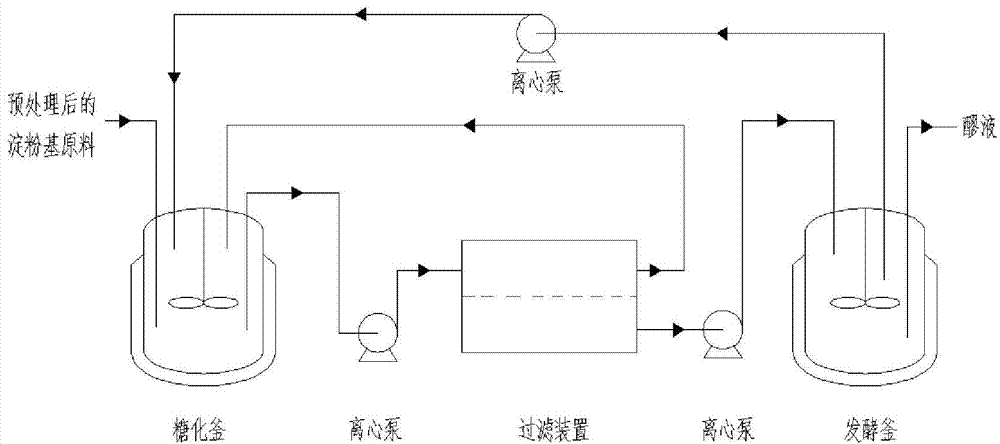Method for producing ethanol by virtue of simultaneous saccharification and fermentation of starch-based biomass
A technology of simultaneous saccharification and fermentation, biomass, applied in the direction of biochemical equipment and methods, bioreactor/fermenter combination, specific-purpose bioreactor/fermenter, etc., to improve saccharification and fermentation efficiency, reduce dosage, reduce cost effect
- Summary
- Abstract
- Description
- Claims
- Application Information
AI Technical Summary
Problems solved by technology
Method used
Image
Examples
Embodiment 1
[0026] A method for synchronous saccharification and fermentation of starch-based biomass to produce ethanol, said method specifically comprising the steps of:
[0027] Take cornstarch with a crushed particle size of 0.3-0.6mm, after high-temperature sterilization, add 15U / g α-amylase and 150U / g glucoamylase, and then mix it with sterile water at a ratio of 1g:3g, and then carry out Feed to the saccharification tank for saccharification at a temperature of 80°C and a pH of 4.5. At the same time, part of the saccharification liquid is transported to the filter device by the centrifugal pump. The pore size of the separation membrane is 0.2 μm, and the filtration method is cross-flow. After filtration, the solid phase (mainly incompletely saccharified starch) is returned to the saccharification tank. The clarified liquid rich in monosaccharides is sent to a fermentation tank containing a high temperature resistant yeast culture at a fermentation temperature of 30°C and a pH of 5...
Embodiment 2
[0029] A process for synchronous saccharification and fermentation of starch-based biomass to produce ethanol, the method specifically comprising the steps of:
[0030] Take the wheat starch that has been mechanically crushed and sterilized by high temperature, add 20U / g α-amylase and 120U / g glucoamylase, then mix it with sterile water at a ratio of 1g:2.8g, and then feed it into the saccharification kettle. Saccharification was carried out under the conditions of temperature 80°C and pH=4.5. At the same time, part of the saccharification liquid is transported to the filter device by the centrifugal pump. The pore size of the separation membrane is 0.2 μm, and the filtration method is cross-flow. After filtration, the solid phase (mainly incompletely saccharified starch) is returned to the saccharification tank. The clarified liquid rich in monosaccharides is sent to a fermentation tank containing a high temperature resistant yeast culture at a fermentation temperature of 30°...
Embodiment 3
[0032] A process for synchronous saccharification and fermentation of starch-based biomass to produce ethanol, the method specifically comprising the steps of:
[0033] Take cassava starch that has been mechanically crushed and sterilized at high temperature, add 12U / g of α-amylase and 120U / g of glucoamylase, then mix it with sterile water at a ratio of 1g:2.5g, and then feed it into the saccharification kettle. Saccharification was carried out under the conditions of temperature 80°C and pH=4.5. At the same time, part of the saccharification liquid is transported to the filter device by the centrifugal pump. The pore size of the separation membrane is 0.2 μm, and the filtration method is cross-flow. After filtration, the solid phase (mainly incompletely saccharified starch) is returned to the saccharification tank. The clarified liquid rich in monosaccharides is sent to a fermentation tank containing a high temperature resistant yeast culture at a fermentation temperature of...
PUM
| Property | Measurement | Unit |
|---|---|---|
| pore size | aaaaa | aaaaa |
Abstract
Description
Claims
Application Information
 Login to View More
Login to View More - R&D
- Intellectual Property
- Life Sciences
- Materials
- Tech Scout
- Unparalleled Data Quality
- Higher Quality Content
- 60% Fewer Hallucinations
Browse by: Latest US Patents, China's latest patents, Technical Efficacy Thesaurus, Application Domain, Technology Topic, Popular Technical Reports.
© 2025 PatSnap. All rights reserved.Legal|Privacy policy|Modern Slavery Act Transparency Statement|Sitemap|About US| Contact US: help@patsnap.com

